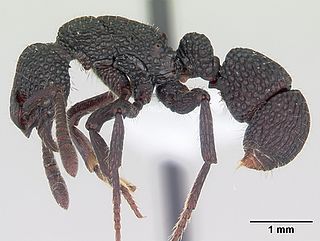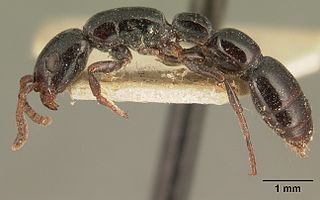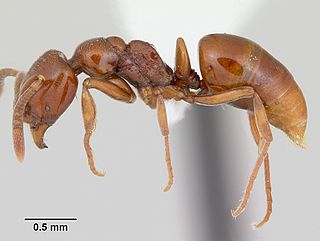
Ponerinae, the ponerine ants, is a subfamily of ants in the Poneromorph subfamilies group, with about 1,600 species in 47 extant genera, including Dinoponera gigantea - one of the world's largest species of ant. Mated workers have replaced the queen as the functional egg-layers in several species of ponerine ants. In such queenless species, the reproductive status of workers can only be determined through ovarian dissections.

Adetomyrma is a genus of ants endemic to Madagascar. Workers of this genus are blind. The type species Adetomyrma venatrix was described in 1994, with the genus being an atypical member of its tribe, the Amblyoponini. This tribe includes the Dracula ants, members of which can feed on the hemolymph of larvae and pupae.

Diacamma is a genus of queenless ants belonging to the subfamily Ponerinae. It is distributed from India to Australia and contains about 24 species.

Cryptopone is a genus of ants in the subfamily Ponerinae. The genus has a worldwide distribution, with most species occurring in Asia. Workers range from very small to medium in size (1.7–6.1 mm), with the queens being slightly larger.

Thaumatomyrmex is a Neotropical genus of ants in the subfamily Ponerinae, found from Mexico to Brazil. They are notable for their pitchfork-shaped mandibles, which they use to capture millipedes of the order Polyxenida. The genus is a specialist predator of polyxenids, and one of only two ant genera known to prey upon polyxenids.

A gamergate is a mated worker ant that can reproduce sexually, i.e., lay fertilized eggs that will develop as females. In the vast majority of ant species, workers are sterile and gamergates are restricted to taxa where the workers have a functional sperm reservoir ('spermatheca'). In some species, gamergates reproduce in addition to winged queens, while in other species the queen caste has been completely replaced by gamergates. In gamergate species, all workers in a colony have similar reproductive potentials, but as a result of physical interactions, a dominance hierarchy is formed and only one or a few top-ranking workers can mate and produce eggs. Subsequently however, aggression is no longer needed as gamergates secrete chemical signals that inform the other workers of their reproductive status in the colony.

Proceratiinae is a subfamily of ants in the poneromorph subfamilies group, with three extant genera, of which most are tropical or subtropical, although overall distribution is worldwide.

Amblyoponinae is a subfamily of ants in the poneromorph subfamilies group containing 13 extant genera and one extinct genus. The ants in this subfamily are mostly specialized subterranean predators. Adult workers pierce the integument of their larvae and pupa to imbibe haemolymph, earning them the common name Dracula ant.

Loboponera is an Afrotropical genus of ants in the subfamily Ponerinae with nine recognized species. The genus is found in central and western Africa, from Ivory Coast to Rwanda. Little is known about their biology.

Leptanilloides is a genus of ants in the subfamily Dorylinae. Leptanilloides is an uncommonly collected genus with subterranean habits in the New World Andean and sub-Andean tropics.

Simopone is a genus of predominantly arboreal ants in the subfamily Dorylinae. The genus is widely distributed in the Old World tropics, with the majority of species in Madagascar and sub-Saharan Africa.

Asphinctopone is a small genus of rarely encountered Afrotropical ants in the subfamily Ponerinae.

Belonopelta is a Neotropical genus of ants in the subfamily Ponerinae. The genus contains two species: B. deletrix is known from Mesoamerica and Colombia, while B. attenuata is only known from Colombia. Members of this genus are rarely collected, and little is known about their habits. Males remain unknown for both species, and queens and larvae have only been described for B. deletrix.

Boloponera is a genus of small ants in the subfamily Ponerinae. The genus contains the single species Boloponera vicans, known from a single worker specimen collected in leaf litter in the Central African Republic. It is sometimes referred to as Bry's ant after its discoverer, Brian Fisher.

Dolioponera is a genus of small ants in the subfamily Ponerinae containing the single species Dolioponera fustigera. The genus is known only from a few specimens from west and central Africa. Little is known about their biology, and males remain unknown.

Odontoponera is a small Southeast Asia genus of ants in the subfamily Ponerinae.

Leptogenys is a genus of ants in the subfamily Ponerinae. Leptogenys is the most diverse ponerine ant genus in the world; it is widespread throughout tropical and subtropical regions and there are over 260 extant species described. Most species have ergatoid queens, and many have falcate, bowed mandibles and are specialists on isopod prey.

Emeryopone is a small genus of ants in the subfamily Ponerinae. The genus is distributed in Asia, from Israel to Indonesia. Little is known about their biology, and males remain unknown.

Promyopias is an Afrotropical genus of ant in the subfamily Ponerinae containing the single species Promyopias silvestrii. The rare genus has previously been regarded as a separate genus, as a subgenus and as a provisional synonymy, but was reinstated at genus-rank in 2008.

Phrynoponera is a strictly Afrotropical genus of ants in the subfamily Ponerinae.


















